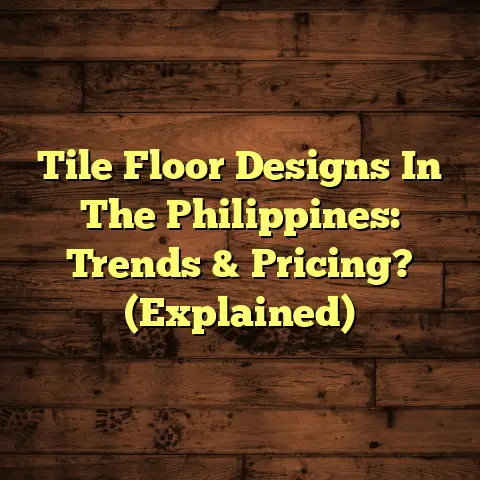Best Fake Wood For Outdoors? (3 Mistakes To Avoid!)
Remember the story of the Trojan Horse?
Beautiful on the outside, but hiding a whole heap of trouble inside?
That’s kind of like choosing the wrong “fake wood” for your outdoor spaces.
It might look amazing at first, but if you don’t do your homework, you could be facing some serious headaches down the road.
As a flooring contractor with over 15 years in the game, I’ve seen it all.
I’ve seen decks warp, patios fade, and beautiful outdoor spaces turn into eyesores because the wrong materials were chosen.
And trust me, replacing a deck is a lot more expensive than doing it right the first time.
So, let’s dive into the world of fake wood and make sure you don’t end up with a Trojan Horse situation on your hands.
Section 1: Understanding Fake Wood
Okay, so what exactly are we talking about when we say “fake wood”?
Well, in the context of outdoor materials, it’s any synthetic product designed to mimic the look and feel of natural wood.
Think of it as wood’s cooler, more resilient cousin.
Here are the main players you’ll encounter:
Composite Decking: This is the big one.
It’s usually made from a mix of wood fibers and recycled plastic.
Brands like Trex, TimberTech, and Fiberon are the big names here.
I’ve installed miles of this stuff, and it’s a solid choice for many applications.PVC (Polyvinyl Chloride): This is straight-up plastic.
It’s super durable and completely waterproof.
Think of it as the Terminator of outdoor materials.
AZEK is a popular brand in this category.Other Engineered Wood Alternatives: This is a bit of a catch-all for newer materials.
Some use rice husks, bamboo, or other recycled materials mixed with polymers.
These are constantly evolving, so keep an eye out for new innovations!
Why go fake? Well, the benefits are pretty clear:
Durability: Fake wood is designed to withstand the elements.
It won’t rot, warp, or splinter like natural wood.Low Maintenance: Forget about staining, sealing, or painting.
A simple wash with soap and water is usually all you need.
Talk about saving time!Pest Resistance: Termites and other wood-boring insects?
Not interested.
This is a huge win if you live in an area with a lot of pests.Consistent Look: Unlike natural wood, fake wood has a consistent color and grain pattern.
This can be a plus if you want a uniform look.
But, it’s not all sunshine and roses.
Fake wood can be more expensive upfront than natural wood.
It can also get hot in direct sunlight (more on that later!).
And, let’s be honest, it doesn’t have quite the same natural charm as real wood.
Section 2: The Growing Popularity of Fake Wood for Outdoor Spaces
I’ve seen the shift firsthand.
More and more homeowners are ditching traditional wood for synthetic alternatives.
Why?
Well, it’s a combination of factors.
First, people are busy!
They don’t want to spend their weekends staining a deck.
They want to relax and enjoy their outdoor spaces.
Low-maintenance materials make that possible.
Second, the quality of fake wood has improved dramatically over the years.
It used to look, well, fake.
But now, many products are incredibly realistic.
You really have to look closely to tell the difference.
Third, there’s the environmental factor.
Many fake wood products are made from recycled materials, which appeals to environmentally conscious consumers.
According to a report by Freedonia Group, the demand for wood decking alternatives is projected to grow 5.5% per year through 2025.
That’s a pretty significant increase!
https://www.freedoniagroup.com/Wood-Plastic-Composite-Decking-and-Railing.html
This growth is fueled by a combination of factors, including increased consumer awareness of the benefits of synthetic materials, rising lumber prices, and a growing emphasis on sustainability.
Even better, many companies are focused on sustainability.
Trex, for example, uses over 95% recycled materials in their decking products.
That’s a win for your outdoor space and a win for the planet!
Section 3: Mistake #1 – Focusing Solely on Aesthetics
Okay, let’s get to the meat of the matter.
This is where I see homeowners go wrong all the time.
They walk into a showroom, see a beautiful deck display, and fall in love with the look of it.
But they don’t think about how it will perform in their specific environment.
That’s mistake number one: Focusing solely on aesthetics.
I get it.
You want your deck to look amazing.
But if that beautiful deck turns into a warped, faded mess after a year, you’re not going to be happy.
Here’s an example: I had a client in Arizona who chose a dark composite decking because it looked fantastic with their modern home.
But Arizona summers are brutal.
That dark decking absorbed heat like crazy, making it almost unbearable to walk on barefoot.
They ended up having to install outdoor rugs just to be able to use their deck!
Different products perform differently.
Some are more resistant to fading, some are better at handling moisture, and some are more durable overall.
Here’s what you need to do:
Research Product Ratings: Look for independent reviews and ratings.
J.D.
Power, for example, publishes customer satisfaction ratings for decking products.
https://www.jdpower.com/business/press-releases/2023-us-decking-satisfaction-studyRead the Warranty: Pay close attention to what the warranty covers and what it doesn’t.
A longer warranty is usually a good sign of a high-quality product.-
Check Performance Specifications: Look for information on things like fade resistance, stain resistance, and impact resistance.
Don’t just trust the salesperson (no offense to salespeople!).
Do your own research and make sure you’re choosing a product that’s going to hold up in your specific climate.
Section 4: Mistake #2 – Ignoring Manufacturer Recommendations
This is another big one.
You’ve chosen a great product, but if you don’t install it correctly, you’re asking for trouble.
Mistake number two: Ignoring manufacturer recommendations.
These recommendations aren’t just suggestions; they’re based on extensive testing and engineering.
They’re designed to ensure that the product performs as intended.
I remember one project where a homeowner decided to install composite decking themselves to save money.
They didn’t follow the manufacturer’s spacing recommendations for the deck boards.
A year later, the boards had expanded and buckled, creating a tripping hazard.
They had to tear the whole thing up and start over!
Here are some common installation mistakes I see:
Improper Spacing: Composite decking expands and contracts with temperature changes.
If you don’t leave enough space between the boards, they can buckle or crack.-
Incorrect Fasteners: Using the wrong type of screws or nails can damage the decking and void the warranty.
-
Inadequate Ventilation: If you’re building a deck close to the ground, you need to ensure adequate ventilation to prevent moisture buildup.
And it’s not just about installation. Maintenance is also crucial.
-
Cleaning: Most fake wood products require regular cleaning to prevent mold and mildew growth.
-
Sealing: Some products may require periodic sealing to protect against fading and staining.
Here’s the takeaway:
-
Read the Installation Manual: Before you even think about starting your project, read the manufacturer’s installation manual cover to cover.
-
Follow the Instructions: Follow the instructions to the letter. Don’t cut corners.
Hire a Professional: If you’re not comfortable with the installation process, hire a qualified contractor.
It’s worth the investment to ensure that the job is done right.
Section 5: Mistake #3 – Overlooking Environmental Factors
We touched on this earlier, but it’s worth diving into deeper.
Your local climate and environmental factors can have a huge impact on the performance of your fake wood.
Mistake number three: Overlooking environmental factors.
What works great in one part of the country might be a disaster in another.
Here are some things to consider:
Extreme Heat: As we saw with the Arizona example, dark-colored decking can get incredibly hot in direct sunlight.
If you live in a hot climate, consider lighter colors or products designed to stay cooler.Humidity: High humidity can promote mold and mildew growth.
Choose products that are specifically designed to resist moisture.Cold Climates: Freezing and thawing can cause some materials to crack or warp.
Look for products that are rated for cold-weather performance.Saltwater Exposure: If you live near the ocean, saltwater can corrode some materials.
Choose products that are specifically designed for saltwater environments.UV Exposure: Prolonged exposure to UV rays can cause fading.
Look for products with UV inhibitors to protect against fading.
Here’s a quick guide:
Pro Tip: Talk to your local building supply store.
They’ll be familiar with the best materials for your specific area.
Section 6: Top Fake Wood Products for Outdoor Use
Alright, now that we’ve covered the mistakes to avoid, let’s talk about some of the best fake wood products on the market.
I’m going to give you my honest opinion based on my experience installing these products.
Keep in mind that everyone’s needs are different, so what works for one person might not work for another.
Here are a few of my top picks:
Trex Transcend: This is a premium composite decking that offers excellent durability, fade resistance, and stain resistance.
It’s also made from 95% recycled materials.
It’s a bit pricey, but it’s worth the investment if you want a deck that will last for years.- Pros: Excellent durability, fade resistance, stain resistance, made from recycled materials.
- Cons: Expensive.
- Pricing: Approximately $12-$15 per linear foot.
- Industry Recognition: Consistently ranked among the top decking products by consumer publications.
TimberTech Azek: This is a PVC decking that’s incredibly durable and completely waterproof.
It’s a great choice for areas with high moisture or saltwater exposure.
It’s also very low maintenance.- Pros: Extremely durable, waterproof, low maintenance.
- Cons: Can get hot in direct sunlight, more expensive than composite decking.
- Pricing: Approximately $14-$18 per linear foot.
- Industry Recognition: Known for its realistic wood look and exceptional performance.
Fiberon Good Life: This is a more affordable composite decking option that still offers good durability and fade resistance.
It’s a great choice for homeowners on a budget.- Pros: Affordable, good durability, fade resistance.
- Cons: Not as durable as Trex Transcend or TimberTech Azek.
- Pricing: Approximately $8-$10 per linear foot.
- Industry Recognition: A popular choice for value-conscious homeowners.
Important Note: Prices can vary depending on your location and the specific retailer.
Be sure to shop around to get the best deal.
Section 7: Maintenance and Care for Fake Wood
Even though fake wood is low maintenance, it’s not no maintenance.
To keep your outdoor space looking its best, you’ll need to do some regular cleaning and care.
Here are some tips:
Regular Cleaning: Wash your deck or patio with soap and water at least once a year.
For tougher stains, you can use a deck cleaner specifically designed for composite or PVC decking.Remove Debris: Sweep or blow off leaves, dirt, and other debris regularly.
This will prevent mold and mildew growth.Protect Against Scratches: Avoid dragging heavy objects across your deck or patio.
Use furniture pads to protect against scratches.Address Issues Promptly: If you notice any warping, fading, or other problems, address them promptly.
The sooner you fix the issue, the less likely it is to become a bigger problem.Seasonal Maintenance: In the fall, remove leaves and debris from your deck or patio before the snow starts to fall.
In the spring, give your outdoor space a thorough cleaning to remove any winter grime.
Common Issues and How to Address Them:
- Mold and Mildew: Clean with a deck cleaner containing a mildewcide.
- Stains: Try a deck cleaner or a stain remover specifically designed for composite or PVC decking.
- Fading: Apply a UV protectant to help prevent further fading.
- Scratches: Minor scratches can often be buffed out with a soft cloth.
Deeper scratches may require professional repair.
By following these simple maintenance tips, you can keep your fake wood outdoor space looking beautiful for years to come.
Conclusion
Choosing the right fake wood for your outdoor space is a big decision.
It’s an investment that you’ll want to enjoy for years to come.
Remember the Trojan Horse.
Don’t be fooled by appearances alone.
Do your research, consider your local climate, and follow the manufacturer’s recommendations.
By avoiding these three common mistakes, you can ensure that you choose a product that will not only look great but also perform well for years to come.
So, go out there and create the outdoor space of your dreams!
And remember, I’m always here to help if you have any questions.
Happy building!





